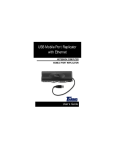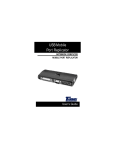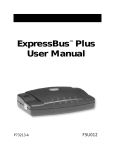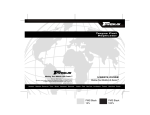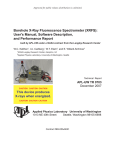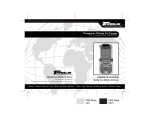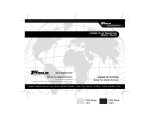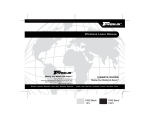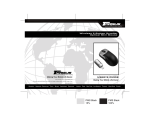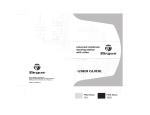Download Targus USB / Serial Adaptor
Transcript
Targus USB Port Adapter Making Your Mobile Life Easier. USER’S GUIDE Visit our Web site at: www.targus.com Making Your Mobile Life Easier. Features and specifications are subject to change without notice. © 2002 Targus Corp. 400-0066-001A BRUSSELS HANNOVER BARCELONA TOKYO MILANO AMSTERDAM SINGAPORE LONDON PARIS NEW YORK LOS ANGELES TORONTO HONG KONG SYDNEY Targus USB Port Adapter Congratulations on your purchase of a Targus USB Port Adapter. This ultra portable expansion cable directly connects to your computer via a Universal Serial Bus (USB) port. This user’s guide describes how to connect the adapter to your computer, install software and hardware drivers, and attach and configure devices. It applies to the following models: • PA082 – Mobile Mini Port Replicator (serial and parallel) • PA084 – USB to Ethernet Cable • PA088 – USB to Serial Cable • PA096 – USB to Parallel Cable In addition to this user’s guide, this package contains one of the Targus USB Port Adapter models listed above and a driver software diskette. System Requirements To use the adapter, your computer must meet the following hardware requirements and run one of the operating systems listed below. Hardware Operating System • PC with a Pentium® processor or • Windows® 98/Me/ equivalent and a hard disk drive 2000/XP • USB V.1.1 compliant port • Standard diskette drive 2 Installing the Device and Drivers To use the Targus USB Port Adapter, you must first install its driver software onto your computer. Then, you can connect it to your computer and install the hardware drivers for the adapter’s port(s). WARNING: You must install the driver software BEFORE connecting the adapter to your computer. Otherwise, the adapter will not work properly. Installing the Driver Software and Connecting the Adapter to Your Computer 1 Turn on your computer (if it’s turned off). 2 Insert the driver software diskette into your computer’s diskette drive. 3 Click Start, Run, then enter A:\Setup.exe (where A: is the path of your diskette drive) and click OK. The Welcome screen appears. Sample Welcome screen (Windows® XP operating system) 3 4 Click Next. 5 If you are running the Windows® XP operating system, the Important Information screen appears. Click Next. The Setup program begins installing the software drivers. The Driver Setup Complete screen appears. Sample Driver Setup Complete screen (Windows® XP operating system) 6 Click Finish. You can now connect the adapter to your computer. To do this, plug the standard USB end of the cable ( ) into an available USB port on your computer. 4 Installing the Hardware Drivers Depending on which model of adapter you have, the adapter needs one or more of the following device drivers installed for its ports: • Ethernet 10/100 • Serial Interface Controller • Parallel Interface Controller Windows® 98/Me Operating System Once you have installed the driver software and connected the adapter to your computer, the device drivers for the ports begin installing automatically. This installation process takes a few minutes. The operating system does not prompt when installation is complete. Watch for all applicable hardware drivers to be installed before opening another application or connecting devices to the adapter. 5 Windows® 2000/XP Operating System If you are running one of these operating systems, you may be prompted to install one or more of the hardware drivers. Sample Found New Hardware Wizard screen (Windows® XP operating system) To install the drivers: 1 Select “Install the software automatically (Recommended)” and click Next. The Found New Hardware Wizard program begins installing the hardware drivers. The Completing the Found New Hardware Wizard screen appears. 2 Click Finish and repeat as needed for each device. 3 Restart your computer. 6 Connecting Devices to the Adapter When connecting new devices to the adapter, you may need to install additional drivers. Consider the following guidelines: • If your computer is running the Windows® 98 operating system, a series of screens appear, beginning with the Add New Hardware Wizard, to guide you through the driver installation process. • If your computer is running the Windows® Millennium Edition, Windows® 2000 or Windows® XP operating system, the device drivers install automatically. • When connecting a new device to the adapter, you must run the Setup or Install program for that device. • When connecting a device to the adapter, do not force the cable connector into the port on the adapter, to avoid possible damage. If the cable connector does not attach smoothly, turn the connector over and try attaching it again. Serial Port To connect serial devices to the adapter and install device drivers: 1 Disconnect the adapter from your computer’s USB port (if connected). 2 Attach the RS232 device to the serial port on the adapter. 3 Reconnect the adapter to your computer’s USB port. 4 Follow any on-screen instructions that may appear to install the default drivers. NOTES: The Windows® 98/Me/2000 operating systems support Plug and Play operation. 7 When connecting a serial device to the adapter, you must disconnect then reconnect the adapter’s USB connector in order for the new device to work properly. Before you can use a serial mouse with the adapter, you must install it as an HID-compliant mouse, which your computer will recognize as a USB mouse. Parallel Port Connecting and Configuring a Printer for the First Time To connect a parallel printer: 1 Plug the printer cable into the parallel port on the adapter. 2 Install the printer software driver according to the instructions that come with the device. 3 When prompted to select a port, choose PB1284-1 (USB port). If this port does not appear in the list, choose the LPT1 port, complete the manufacturer’s setup for your printer, and refer to the instructions below to redirect your printer. Checking and Redirecting the Printer Port Settings Follow these instructions to check the printer port settings and redirect your printer from the LPT1 port to the PB1284-1 (USB port) on the adapter. 1 With the printer connected to the adapter’s parallel port, select Start, Settings, and then Printers. 2 Right-click the printer device you are reassigning and select Properties. 8 3 In the Printer Properties window, select Details or Connection for the Printer. (Section titles vary, so check your printer’s user manual for specific instructions.) 4 Change the setting to PB1284-1 (USB port) to redirect printing to the adapter. Ethernet Port To connect an RJ-45 ethernet cable, attach the cable connector to the ethernet port on the adapter. Additional procedures to connect to an actual network depend on the type of network you are using. Contact your network administrator for detailed instructions. Troubleshooting General Device Not Working • Disconnect the adapter from your computer’s USB port, then reconnect it. • Check that your computer is turned on, that it is charged (if running on a battery) and that the device is plugged in and turned on (if applicable). • Make sure that the adapter is firmly connected to both your computer and the device. • Disconnect the device from the adapter, then reconnect it and restart your computer. • Verify that you ran the Setup or Install program for the device. • Make sure that the device appears in Device Manager. For more information refer to the following instructions (overleaf). 9 Verifying Devices are Installed You can view the devices installed on your computer from the Device Manager window in System Properties. To access Device Manager for the Windows® 98/Me operating systems, right-click My Computer, then click Properties, and the Device Manager tab. For the Windows® 2000/XP operating systems, right-click My Computer, then click Properties, the Hardware tab, and the Device Manager button. Sample Device Manager screen (Windows® 98 operating system) From the Device Manager window, depending on the model of adapter you have, expand the following: Model PA082 – Mobile Mini Port Replicator • Human Interface Devices — displays USB Human Interface Device (Windows® Me/2000/XP operating system) 10 • Parallel Port — displays Parallel Interface Controller (Windows® 98 operating system) • Ports (COM & LPT) — displays the path Serial on USB [COMx] if present (where x is the COM port number) (Windows® 98 operating system) • Universal Serial Bus controllers — displays the USB Port Adapter. Model PA084 – USB to Ethernet Cable • Network adapters — displays USB Ethernet 10/100 • Universal Serial Bus controllers — displays the USB Port Adapter. Model PA088 – USB to Serial Cable • Human Interface Devices — displays USB Human Interface Device (Windows® Me/2000/XP operating system) • Ports (COM & LPT) — displays the path Serial on USB [COMx] if present (where x is the COM port number) (Windows® 98 operating system) • Universal Serial Bus controllers — displays the USB Port Adapter. • Mouse (or Mice and other pointing devices) — check that the HID-compliant mouse is present (if you have installed a serial mouse) Model PA096 – USB to Parallel Cable • Parallel Port — displays Parallel Interface Controller (Windows® 98 operating system) • Universal Serial Bus controllers — displays the USB Port Adapter. 11 Parallel Port (Models PA082 and PA096) Printer Not Found If your parallel printer is not working, refer to “Checking and Redirecting the Printer Port Settings” on page 8 for instructions on how to verify and change the port settings. Serial Port (Models PA082 and PA088) Verifying a Serial Modem Connection When attaching a modem to the serial (RS232) port, verify that the port assigned to your modem is Serial USB (COMx), where x is the number of the COM port. If the operating system does not detect automatically that your modem is assigned to Serial USB (COMx), rerun the Hardware Wizard and choose Select from a list instead of Autodetect. Then, select Serial USB (COMx) as the COM port. Specifications Cable Length PA082 PA084 PA088 PA096 1-foot (0.3 m) 6-foot (1.8 m) 6-foot (1.8 m) 6-foot (1.8 m) Power Consumption PA082 PA084 PA088 PA096 180 mA 120 mA 150 mA 150 mA 12 Technical Support In the unlikely event that you encounter a problem with your Targus accessory, please contact our technical support team at: Email: [email protected] Internet: http://www.targus.com/support Our knowledgeable staff is also available to answer your questions through one of the following telephone numbers. North America Monday through Friday, 8:00 a.m. (08:00) to 8:00 p.m. (20:00) Eastern time: US & Canada 800-283-6325 Europe Belgium +32 0 02-717-2451 Denmark +45 0 35-25-8751 France Germany +33 0 1-64-53-9151 +49 0 21-16-579-1151 Italy +39 0 24-827-1151 Netherlands +31 0 53-484-9470 Spain Sweden Switzerland United Kingdom Eastern Europe & others +34 0 91-745-6221 +46 0 8-751-4058 +41 0 1-212-0007 +44 0 20-7744-0330 +31 0 53-484-9479 13 Product Registration For more efficient customer service and to activate the product’s warranty, Targus recommends that you register your Targus accessory shortly after purchasing it. To register your Targus accessory, go to: http://www.targus.com/registration.asp You will need to provide your full name, email address, phone number, and company information (if applicable). Warranty Targus warrants this product to be free from defects in materials and workmanship for one year. If your Targus accessory is found to be defective within that time, we will promptly repair or replace it. This warranty does not cover accidental damage, wear and tear, or consequential or incidental loss. Under no conditions is Targus liable for loss of, or damage to a computer; nor loss of, or damage to, programs, records, or data; nor any consequential or incidental damages, even if Targus has been informed of their possibility. This warranty does not affect your statutory rights. Warranty Registration at: http://www.targus.com/registration.asp Regulatory Compliance This device complies with Part 15 of the FCC Rules. Operation is subject to the following two conditions: (1) This device may not cause harmful interference, and (2) This device must accept any interference received, including interference that may cause undesired operation. FCC Statement Tested to Comply This equipment has been tested and found to comply with the limits of a Class B digital device, pursuant to Part 15 of the FCC Rules. These limits are designed to provide reasonable protection against harmful interference in a residential installation. This equipment generates, uses, and can radiate radio frequency energy and if not installed and used in accordance with the instructions, may cause harmful interference to radio communications. However, there is no guarantee that interference will not occur in a particular installation. 14 If this equipment does cause harmful interference to radio or television reception, which can be determined by turning the equipment off and on, the user is encouraged to try to correct the interference by one or more of the following measures: • Reorient or relocate the receiving antenna • Increase the separation between the equipment and receiver • Move the computer away from the receiver • Connect the equipment into an outlet on a circuit different from that to which the receiver is connected. Windows is a registered trademark of Microsoft Corporation. All other trademarks are the property of their respective owners. 15















